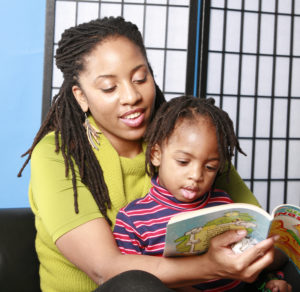24 At-Home Learning Activities to Share with Parents of Young Children
March 17, 2020
*We originally published this post near the beginning of the COVID-19 pandemic. While some things have changed since then, the activities in this post are still great skill-builders for young children!
As schools close due to COVID-19 concerns and new guidelines on social distancing take effect, many parents are home with their young children—and looking for new ways to keep them occupied while building on the skills they’ve been learning in the classroom. Keeping kids engaged and active (without overusing screens!) can be tough during an unexpected break like this, especially when new safety recommendations put a temporary hold on play dates, restaurant trips, and visits to crowded parks, zoos, and other places kids love.
If you’re a parent of young children—or if you work with families—today’s post is tailored especially for you. We’re bringing you a collection of 24 at-home learning activities parents can use to boost their child’s academic, motor, communication, and social-emotional skills while they’re home from school. Adapted from some of our best books on early childhood development and education, these fun and inexpensive activities will keep kids learning and give you easy ways to connect with them during this unexpected break in routine.
Please share these ideas with any families who might benefit, and if you have a favorite at-home activity to share, add it in the comments below!
Academic skills
 Give mealtime a math infusion. Do your kids like to help out in the kitchen? Meal prep is the perfect time to get children counting, measuring, estimating, comparing, and recognizing shapes. Ask your child to measure and count cups of ingredients, count how many plates and utensils are needed for the whole family, and figure out who has more or less mashed potatoes. Get creative with math during cleanup time, too: you can have your child name the shapes of the dishes and sponges, count the number of steps they took to complete the cleanup task, and predict how many dishes will fit in the dishwasher. (Want more ideas? Download this free tip sheet for 24 ways to have fun with math at home.)
Give mealtime a math infusion. Do your kids like to help out in the kitchen? Meal prep is the perfect time to get children counting, measuring, estimating, comparing, and recognizing shapes. Ask your child to measure and count cups of ingredients, count how many plates and utensils are needed for the whole family, and figure out who has more or less mashed potatoes. Get creative with math during cleanup time, too: you can have your child name the shapes of the dishes and sponges, count the number of steps they took to complete the cleanup task, and predict how many dishes will fit in the dishwasher. (Want more ideas? Download this free tip sheet for 24 ways to have fun with math at home.)
Supercharge your storytimes. Your daily book reading sessions are golden opportunities to actively build early literacy skills. To boost vocabulary knowledge, watch for words you think your child may not know and briefly define and talk about them. When you reread a book, ask your child if they remember what the word means, and try to use the new words at other times of the day to reinforce knowledge. To build letter recognition skills, try pointing to letters as you say their names, singing a slowed-down ABC song while you point to each letter in the book. Turn to random pages in the book and see if children can name and point to the letters themselves. You can follow up by having your child make their own ABC book, finding or drawing pictures for each letter.
 Reread all your child’s comfort books. When you’re home together and it seems like life is slowing down, sink into some comfort rereads of favorite picture books. Kids love hearing the same book many times, and the repetition is actually beneficial to their developing literacy skills, since it gives them multiple chances to absorb the language of the book. If you want to make the most of repeated readings, choose high-quality books with words that stretch your child’s vocabulary and language knowledge.
Reread all your child’s comfort books. When you’re home together and it seems like life is slowing down, sink into some comfort rereads of favorite picture books. Kids love hearing the same book many times, and the repetition is actually beneficial to their developing literacy skills, since it gives them multiple chances to absorb the language of the book. If you want to make the most of repeated readings, choose high-quality books with words that stretch your child’s vocabulary and language knowledge.
Make a museum. Your child but can make a museum at home with a little imagination and a few simple materials. If your child has collected little treasures over the years (rocks, shells, toy dinosaurs, buttons, etc.), show them how to arrange their collections in themed displays using shoe boxes, small jars, or egg cartons. Help children label their treasures—a great way to practice letter writing and recognition—and build their language skills by encouraging them to give “tours” of their personal museum to visitors. (While you’re teaching young children at home, a virtual museum tour might also be a fun way to spark conversations about art and history.)
Start a language-rich restaurant at home. If your kids love restaurants, why not start one at home, and use it to help teach language and literacy skills? Stock your play area with empty boxes, food containers, and restaurant props with writing on them, such as takeout menus, placemats, or a newspaper circular. Read the menu with them, or help them create their own menus from scratch. Help kids make a sign with their restaurant’s name. As children play, point out words on the restaurant props and encourage them to spot familiar letters and words.
 Create a dedicated writing center. To make writing/prewriting activities inviting to young children, designate a table or desk as your home’s “writing center.” Fill it with open-ended materials that invite exploration and experimentation. Offer kids blank paper in different colors, a small dry erase board, markers, crayons, pencils, scissors, glue sticks, hole punches, and envelopes. Kids who have a variety of materials on hand will be more likely to initiate self-directed writing projects.
Create a dedicated writing center. To make writing/prewriting activities inviting to young children, designate a table or desk as your home’s “writing center.” Fill it with open-ended materials that invite exploration and experimentation. Offer kids blank paper in different colors, a small dry erase board, markers, crayons, pencils, scissors, glue sticks, hole punches, and envelopes. Kids who have a variety of materials on hand will be more likely to initiate self-directed writing projects.
Measure their masterworks. Are your kids passing the time by making a long cardboard road for their cars, or building a tall tower with blocks? Dig out your ruler and incorporate a little measurement lesson into their play. Show them how to use the ruler to measure the length of their road or the height of their tower. They might have fun predicting how many inches long or feet high their creations are.
 Help math and science skills bloom in your garden. If you’re working on a garden, this is a perfect opportunity to teach math and science concepts while your kids get some fresh air. Have them measure water into a watering can, count seeds, start tallying days on a calendar to keep track of plant growth, and record observations. (If you don’t have a backyard, you can start a windowsill garden with kids. They can measure soil into small pots, count and plant seeds, predict which seeds will sprout first, and make observations.)
Help math and science skills bloom in your garden. If you’re working on a garden, this is a perfect opportunity to teach math and science concepts while your kids get some fresh air. Have them measure water into a watering can, count seeds, start tallying days on a calendar to keep track of plant growth, and record observations. (If you don’t have a backyard, you can start a windowsill garden with kids. They can measure soil into small pots, count and plant seeds, predict which seeds will sprout first, and make observations.)
Communication skills
Have an adventure—without leaving your living room. Sit with your kids on a rug or couch and pretend you’re leaving for a big adventure on a magic carpet, submarine, or school bus. Ask them to share their ideas on where they want to visit, and take turns concocting a story about your adventure. Describe the sights you see and ask kids questions that invite their creative participation: “Look, there’s a circus! Can you see the elephants? What are they doing?” “Do you see that school of fish? What do you think fish learn about in school?” This is a great way to strengthen communication skills while having fun with kids who feel cooped up.
 Put on a play. Encourage your kids to collaborate on a short play using a few puppets. They can adapt a familiar story or fairy tale, or create their own story together. After they put on the play, talk with them about the story and characters, and ask them questions about how they developed the play.
Put on a play. Encourage your kids to collaborate on a short play using a few puppets. They can adapt a familiar story or fairy tale, or create their own story together. After they put on the play, talk with them about the story and characters, and ask them questions about how they developed the play.
Set up a home office for kids. This is an indoor activity kids love—they’ll enjoy the chance to be “just like you.” Set up a pretend office in a corner of your home where kids can make calls, write letters and “send” them, and type important emails. Be sure to provide lots of varied materials for them to work with: an old keyboard to type with, file folders and paper, a calculator, an old phone (toy or real), pens and pencils, tape, envelopes, rubber stamps, and notepads. Then pretend with them—give them a “call” and ask when the mail will be arriving, or ask to have a face-to-face meeting in their office.
 Start your own store. Open your own department store in your room or in the playroom. Encourage kids to play different roles—shopper, sales clerk, cashier—and communicate with each other in character (or you can play one or more roles). This is an ideal activity to try if you’ve been doing spring cleaning; children can browse the items you’re getting rid of and “buy” a few items with pretend money.
Start your own store. Open your own department store in your room or in the playroom. Encourage kids to play different roles—shopper, sales clerk, cashier—and communicate with each other in character (or you can play one or more roles). This is an ideal activity to try if you’ve been doing spring cleaning; children can browse the items you’re getting rid of and “buy” a few items with pretend money.
Have some flashlight fun. This activity can help boost communication skills while easing your child into bedtime. Once your child is in bed, give them a flashlight and play with it together in the darkened room. Take turns shining the light on different things. Ask your child questions about the items in the room, and talk about what you see. Whisper and laugh together, and make up a silly story. Bedtime chats like these hone language skills while helping your child feel safe, secure, and calm.
Motor skills
 Enjoy the outdoors. Engage in outdoor family activities that give your child’s motor skills a pick-me-up. Choose activities that involve both gross motor skills (running, jumping, playing catch, dribbling a ball) and fine motor skills (collecting and sorting objects, using small tools). Go on a family walk and play “I Spy.” Have an outdoor family dance party. Collect things like pinecones, acorns, and pretty stones in a pail, and help your child sort them into groups. Make and hang homemade feeders for your backyard or windowsill birds. Your kids will get critical motor skills practice, and the fresh air and fun will give everyone an emotional boost.
Enjoy the outdoors. Engage in outdoor family activities that give your child’s motor skills a pick-me-up. Choose activities that involve both gross motor skills (running, jumping, playing catch, dribbling a ball) and fine motor skills (collecting and sorting objects, using small tools). Go on a family walk and play “I Spy.” Have an outdoor family dance party. Collect things like pinecones, acorns, and pretty stones in a pail, and help your child sort them into groups. Make and hang homemade feeders for your backyard or windowsill birds. Your kids will get critical motor skills practice, and the fresh air and fun will give everyone an emotional boost.
Open your own “art school.” Start by reading your child some favorite picture books and talking about the different techniques the artists used for the illustrations. Then have the child practice fine motor skills by making books or illustrations of their own, using materials such as watercolors, paste, paper, cloth scraps, ribbon, foil, string, stamps, greeting cards, and box tops. When they’re done, your kids can hang their masterpieces in a special gallery area or “read” their illustrated books to you or each other.
 Try some target practice. Cut a few 8- to 9-inch holes in a big piece of cardboard, draw a target with chalk on a sidewalk or in your driveway, or pick a target outside, such as a tree, your garage door, or the side of your apartment building. Encourage your child to try to throw a beanbag or small ball through the holes or at the target. Have your child start very close to the target and then move back a few feet, and show them how to throw underhand and overhand. Be sure to cheer for them when they hit the target.
Try some target practice. Cut a few 8- to 9-inch holes in a big piece of cardboard, draw a target with chalk on a sidewalk or in your driveway, or pick a target outside, such as a tree, your garage door, or the side of your apartment building. Encourage your child to try to throw a beanbag or small ball through the holes or at the target. Have your child start very close to the target and then move back a few feet, and show them how to throw underhand and overhand. Be sure to cheer for them when they hit the target.
Make egg carton caterpillars. If you use up lots of eggs, here’s a fun fine-motor activity to do with those leftover cardboard egg cartons. Cut the egg section of the cartons into strips, one for each child in your house. Have each child choose a caterpillar body and decorate it with paint or markers or by gluing on different colors or textures of paper. Pipe cleaners make great antennae, and children may even want to add some pipe cleaner legs to their caterpillar. Remind them to draw or glue on a face!
Outline an animal. Does your child have a favorite animal? Draw a simple silhouette of the animal on a big piece of paper and give your child some glue and a bowl of Cheerios or uncooked pasta shapes. Then have the child outline the animal by gluing the cereal or pasta pieces to the page, following the lines you drew. (Always supervise carefully when children are working with small items that could be a choking hazard.)
Social-emotional skills
 Have regular emotional check-ins. During challenging times, young children can easily pick up on the stress and worry of the adults in their lives. Disruptions to regular schedules, troubling news stories, and overheard adult conversations can leave a child confused and concerned about the future. Set aside time to check in and connect with your child every day. Talk about your day and what will happen tomorrow. Ask them simple questions: “What was the best part of today?” “Were there any hard parts?” “How did you feel?” “Do you have anything you’d like to talk about?” Listen carefully to what your child says so they know their thoughts and emotions are important to you. (For more social-emotional skill-boosters for children ages 2 months through 5 years, print these free ASQ:SE-2 activity sheets.)
Have regular emotional check-ins. During challenging times, young children can easily pick up on the stress and worry of the adults in their lives. Disruptions to regular schedules, troubling news stories, and overheard adult conversations can leave a child confused and concerned about the future. Set aside time to check in and connect with your child every day. Talk about your day and what will happen tomorrow. Ask them simple questions: “What was the best part of today?” “Were there any hard parts?” “How did you feel?” “Do you have anything you’d like to talk about?” Listen carefully to what your child says so they know their thoughts and emotions are important to you. (For more social-emotional skill-boosters for children ages 2 months through 5 years, print these free ASQ:SE-2 activity sheets.)
Pound some dough together. Mushing, squeezing, and pounding dough is a great activity for helping kids process feelings of anger, frustration, and helplessness (and housebound grownups might find this just as therapeutic). Mix up some cookie dough (like these “Get the Mad Out” cookies on the PBS website) and mash and knead it together. Or if baking isn’t your thing, let the kids smush and pound play dough or clay. They’ll let off steam in a safe way and hone their creativity at the same time.
Encourage nurturing play. When the world feels scary, nurturing dolls and stuffed animals is a good way for children to refocus their feelings and practice caring behavior. Set up toy cribs where children can put their “babies” to bed, water tables where kids can bathe their dolls, and places where the babies can be fed with old bottles, sippy cups, and spoons. Help children create caregiving scenarios and praise children for their TLC. (Be sure to include kids of all genders in this activity—every child can benefit from practicing their caring skills.)
 Use books as bibliotherapy. Book reading is one of the best ways to help children deal with fears and worries. Select books that deal with big changes and tough emotions and have reassuring endings. Discuss how the characters dealt with adversity, adjusted to a new situation, and managed their fears. Learning about characters who faced difficult situations and emerged triumphant can help assure children that their family can make it through hard times, too.
Use books as bibliotherapy. Book reading is one of the best ways to help children deal with fears and worries. Select books that deal with big changes and tough emotions and have reassuring endings. Discuss how the characters dealt with adversity, adjusted to a new situation, and managed their fears. Learning about characters who faced difficult situations and emerged triumphant can help assure children that their family can make it through hard times, too.
Try some therapeutic art, too. Art activities are more than just fun—they can provide children with a powerful outlet for their emotions. Alice Honig describes one example in her book Little Kids, Big Worries: “Lonnie drew a bus and then scribbled all over it with a brown marker. The teacher was puzzled. She did not act disappointed by his scribbles. She did ask him gently to tell her about his picture. The child soberly explained, “That is the ambulance that took my dad to the hospital.’ The brown scribbles over Lonnie’s picture expressed his dark scared feelings about his father’s illness.” Teach children how art can be a healthy way to process difficult emotions, and provide them with lots of different materials they can use to express whatever they might be feeling: pages from magazines, photos, stickers, paint and markers in vivid colors, etc.
 Share a story from faraway family members. Many children find it hard to be separated from extended family members, including grandparents, aunts, uncles, cousins, and close family friends. Reach out and ask a few beloved family members to record themselves reading your child a story out loud. Your child can follow along in the book with them or just enjoy listening. This can be a wonderfully reassuring experience!
Share a story from faraway family members. Many children find it hard to be separated from extended family members, including grandparents, aunts, uncles, cousins, and close family friends. Reach out and ask a few beloved family members to record themselves reading your child a story out loud. Your child can follow along in the book with them or just enjoy listening. This can be a wonderfully reassuring experience!
We hope this post gave you some new ideas to try with kids, and we wish you and your loved ones continued good health and safety. Please let us know how else we can support you in the weeks to come!
MORE FREE RESOURCES
20 Stress-Busters for Young Children (designed for early childhood classrooms, but many of the activities can be adapted for home use)
24 Ways to Have Fun with Math at Home
Sample ASQ-3 Learning Activity Sheets
Sample ASQ:SE-2 Learning Activity Sheets
EXPLORE THE BOOKS
The activities in this post were adapted from and inspired by the following books:
Activities 1 and 8: Let’s Talk About Math by Donna Kotsopoulos and Joanne Lee
Activities 2 and 3: Connecting Through Talk by David K. Dickinson & Ann B. Morse
Activities 2, 4, 9, 15, and 22: Talk to Me, Baby! by Betty Bardige
Activities 5-7: Blended Practices for Teaching Young Children in Inclusive Settings, Second Edition, by Jennifer Grisham-Brown, Mary Louise Hemmeter, and Kristie Pretti-Frontczak
Activities 10, 11, 14, and 16: ASQ®-3 Learning Activities by Elizabeth Twombly and Ginger Fink
Activities 12, 17, and 18: Early Literacy in Action by Betty H. Bunce
Activities 13, 19, and 24: ASQ®:SE-2 Learning Activities by Elizabeth Twombly, Leslie Munson, and Lois Pribble
Activities 20,21, and 23: Little Kids, Big Worries by Alice Sterling Honig




Write a Comment
Your email address will not be published. Required fields are marked *
comments
Amy Lambert says
How can I share this with my parents?
jlillis says
Hi Amy--would it work to distribute the link to this article via email? Or if your program has a website, you're very welcome to post it there, as long as you credit and link back to us. Would it help to have it in another format?
Lydia Vazquez says
Lydia Vazquez
March 20, 2020
Is this available in another language (Spanish) I have children with dual language
jlillis says
Hi Lydia--we don't have a translation available at the moment, but I will pass this request on to our department director. Thanks!
Logan Brown says
Awesome article! It’s a tough time for children, who have to stay indoors and a challenging time for parents as well. Communal park times are indeed getting difficult, and if at all it’s possible, parents need to consider the sanitation of the playground equipment. This is applicable to the backyard DIY playgrounds as well.
Parul Gupta says
Great article.
As a parent of a young child, these tips will really help me a lot to encourage my kid to try & learn new things.
jlillis says
So glad you found this article helpful! Thank you for reading!
Marky says
Really Awesome Ideas You Have shared for the community, Thank you for sharing.
Pearl says
Its of great help, loved the ideas! I had personally tried this https://bit.ly/2PKSvgS for my kids to learn at home.
Noori says
Thanks for sharing these great ideas with us. My favourite fun activity with my child is to give her a task sheet each day where she finishes tasks that include either colouring, counting and circling the correct answer, organising her to cabinet, etc. It keeps her busy and active. Sometimes she comes up with her own ideas and we try to play to few games.
jlillis says
Thanks, Noori! Great idea--we're so glad you shared it with us!
Best Nanny Training Institute in India says
Thanks for string this valuable information
Sara says
Most important thing, like the key to success in homeschooling, is to entertain your child. The fact that she/he is spending time with paret is the big advantage. Other thing is that you shouldn't creat a regular school at home. You can be creative and/or go with the best methods. One of them is to use chess. You need to interest them with something. In my opinion chess is the best game, because it's impossible to get bored by it. So many possibilities, different situations, and you don't always need to play all the game or need someone to play with. You can always focus on solwing the chess problems. I can recommend a very good and briliant book, that can bring you a lot of fun. It's alll about chess. The rules of chess are very simple and children can learn them already from around the age of three. Not everyone can or wants to become a professional chess player but everyone can use chess for learning. For this purpous I can recommend a book (net-boss.org/chess-puzzles-for-kids-by-maksim-aksanov) with bunch of great exercises, which will help you and your kids to be better in this :)
Winnie says
Wow! Really the great ideas you have shared with us. It will be helpful to many parents to keep their kids engaged in various activities!
Post a Comment